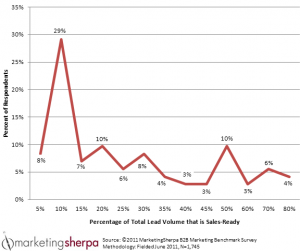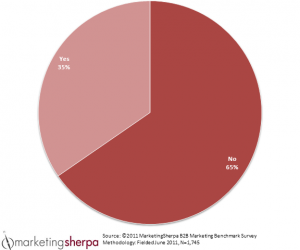Email Marketing: The importance of lead nurturing in the complex B2B sale
While gathering presentation material for the upcoming MarketingSherpa Email Summit 2012 (February 7-10 at Caesars Palace Hotel and Casino in Las Vegas), I had the chance to reach out to Jen Doyle, Senior Research Manager, MarketingSherpa, to get some additional background on lead re-engagement and nurturing.
Jen was the lead author of the 2012 B2B Marketing Benchmark Report, and was very helpful in finding a couple of relevant charts for me, providing some additional comments on what this research means for B2B marketers.
73% of all B2B leads are not sales-ready
The first lesson Jen offers is almost three quarters of all B2B leads are not sales-ready. This means Marketing needs to engage with those leads in some fashion to move them down the buying funnel. This also means it’s possible for leads to “go cold” somewhere between entering the funnel and becoming sales-ready. Those are the leads Marketing needs to reengage with.
Here is the first chart of MarketingSherpa research Jen provided:
Chart: Average percentage of total lead volume that is sales-ready
And here is Jen’s commentary:
The above chart is the demonstration of why all leads cannot go directly to Sales.
At the time of original lead conversion, an average of 27% of those leads will be qualified to the point where they are ready and willing to engage with Sales.
The remaining 73% are not there yet. When these leads are prematurely sent over to Sales, they are not receiving the experience they desire and will look elsewhere for it.
Besides, do you really want your Sales team spinning their wheels making dial after dial where nearly three-quarters of those leads are not ready?
So, a large majority of B2B leads are not ready for Sales. This is where lead nurturing campaigns come into play.
The usual touch point for lead nurturing is email. These campaigns are greatly enhanced by utilizing marketing automation software to track and score those leads, and send triggered email based on demographic, firmographic, and probably most importantly as the lead moves closer to be becoming sales-ready, behavioral information. Behavioral information would include website visits, whitepaper downloads, webinar participation, and similar activities that indicate the lead is getting ready to buy the product or service.
With that in mind, this second chart is not good news for many B2B marketers:
Chart: 65% of B2B marketers have not established lead nurturing campaigns
Here are Jen’s comments on this dismaying bit of research:
Despite the increasing challenges marketers are facing today, the adoption of latest best practices to address them is sluggish.
For example, 65% of our survey respondents indicated that they have not yet established lead nurturing campaigns, despite a demonstrated 35% lift in lead generation ROI (2011 MarketingSherpa B2B Marketing Benchmark Survey).
Our buyers have changed and in order to succeed in attracting and converting them, we must adapt the way we market to them.
The big lesson here is that our research shows that most leads are not ready for Sales, and because of that reason, need nurturing.
Unfortunately, our research also shows that most B2B marketers are not taking advantage of lead nurturing activities, and because of that are most likely leaving promising prospects somewhere in the buying cycle, but not getting to the point of a closed deal.
Let us know what sort of lead nurturing you do in your marketing efforts. Also, are there any nurturing case studies or how-to guides that might best help your campaigns in 2012? Tell us what you would like to see and we’ll do our best to track those stories down.
Related Resources:
B2B How-To: 5 lead nurturing tactics to get from lead gen to sales-qualified
Email Marketing: Anti-newsletter strategy nurtures $1.5 million in leads in 4 months at Citrix
Lead Nurturing and Management Q&A: How to Handle 5 Key Challenges
Email Marketing: Global telecom combines email and content strategy to segment database
Trigger Happy: Why emails are the magic bullets of marketing automation and shopping cart recovery
Funnel Optimization: Why marketers must embrace change
Marketing Funnel: How to optimize your Sales and Marketing funnel in 5 steps
Categories: Email Marketing B2B marketing, Email Marketing, Email Summit 2012, lead generation, lead nurturing, sales-ready












Tell me something I haven’t head a thousand times.
David,
This is yet another article that reminds me of the massive amount of content entrepreneurs and marketers need to create for their companies. The main reason businesses don’t adopt the simple things like blogs and the more complicated things like lead nurturing campaigns with whitepapers and seminars is because of the content that needs to be created and the time that needs to be spent on doing so.
I know from HubSpot’s work that the majority of the new content created is consistently recycled into new formats with different perspectives. This is probably the best way to go about content creation I’m guessing? It’s tough for us perfectionists out here who want earth-shattering content every time we publish something haha.
There is no argument that lead-nurturing, blogging, content, brings in customers for a significantly smaller cost-per acquisition than traditional advertising but the amount of time needed to create that content seems like it may reduce that CPA if man hours are included in the calculation. That is unless there is a streamlined approach to its creation.
How do the MECLabs sister companies handle this daunting task?
P.S. Strong article, it just got my thinking and I’d love the MECLabs input on these questions.
Jeff,
I think the key with these data points is 73% of B2B leads are not Sales-ready, but at the same time 65% of B2B marketers are not nurturing those leads.
So even though this a message we really push, clearly not everyone is receiving the news. But I’m very glad you have — tell us, what sort of nurturing are you doing right now?”
Thanks Nick,
Here’s my perspective (and only represents my own thoughts).
First of all, for a good example of why content is more valuable than traditional advertising for many companies, check out the case study about long-tale search in this Thursday’s upcoming Inbound Marketing newsletter (if you’re not already subscribed, you can do so here.)
Second, advertising needs content, too. That is, traditional advertising is not just a blank media buy. True, many ad agencies have traditionally made most of their money off of the media buys, but as I’m sure you know, creative time isn’t cheap either. I have worked as an advertising copywriter as well, and we used to charge $100 per hour…and I know many agencies charge much more.
At MECLABS, we look at content as an investment. The primary role of content is to serve the audience and provide them value. To that end, we hire content professionals who’s job it is to do just that. (After all, you better sell your free content as well.)
We realize that, if we truly serve our audience, 99% may never become a Research Partner. But by truly serving that 99%, we are then able to talk to the 1% who would find value from engaging with us.
But you’re absolutely right. It’s not easy task and the price is steep. We can’t do all the things we want to do all the time. In the past our focus has been the Quarterly Research Journal. Now we’ve shifted to focus more on video. But the one thing that will never change, is the focus on serving our audience with real value through our content.
Thanks Daniel,
David Ogilvy frequently referred to direct marketers to see what worked for them before doing his copywriting for major brand campaigns, while I don’t have clients anywhere near as noteworthy as his were, I do the same. Here I mention one of my favorite places for finding high converting sales pages (http://tinyurl.com/7xhngnu).
If you take a look there you’ll notice that many of the top selling (converting) products use video in their sales pages instead of the traditional long form sales pages. I know, as you and the rest of the MECLabs team does, that long form sales pages have always tested better than short form sales pages (strictly sales pages here not email).
I started writing this response because based on your comment above it sounds like MECLabs has moved to video creation because you may have noticed a higher conversion percentage of subscribers? Either that or the creation of video is simply a better time than writing.
A landing page optimization test comparing a long form sales page vs. a video sales page would be very interesting. The content would be the exact same on each one of these pages but the medium that delivers it would be the test. Has MECLabs conducted any test along these lines?
Interesting points you got here. Really a lot of companies disregard lead nurturing as a part of their sales process. Which I think they need to really consider, prospects may not be in the buying mode during your first contact but wouldn’t you consider him if he might be exploring other providers in the next few months? And I definitely agree that content may it be in text, video or any digital format can primarily help in nurturing b2b sales leads. With a great content you can encourage and give your prospects the possible benefits and business opportunities that you will provide.